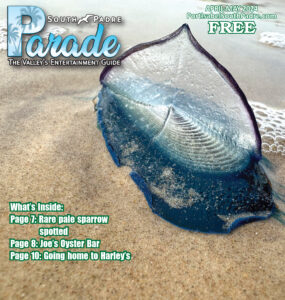By STEVE HATHCOCK
Special to the PRESS
“The foot locker, as our family has been calling it, belonged to my maternal grandfather. After he passed away in 1981 the foot locker went first to his son and then to my aunt. I was very close to my grandfather growing up. That, combined with my natural curiosity, gave her the idea of sending me the foot locker for safe keeping.
I wonder why some things were saved. Was it totally random, that on the day of his discharge, this was what was there and he brought it all home. Had he been saving these items? Sadly, no one asked.”
Jim
Hi Jim, thanks for the query. I believe I can answer some of your questions.
First, let me give you a brief history of the ship your grandfather served on. Built by the Chicago Bridge and Iron Company (Seneca, Illinois) the LST 208 was commissioned June 8, 1943. She saw combat in both the Atlantic, (Invasion at Normandy better known as D-Day and the invasion of Italy (referred to as Operation Slapstick by the British) and in the Pacific during Operation Ratchet, or the invasion of Borneo.
Tank transport LSTs carried a crew of 104 enlisted men and seven officers. Typical loads carried by the craft could include tanks, wheeled and tracked vehicles, artillery, construction equipment and military supplies. A fully loaded LST would careen as close to shore as possible before unloading its cargo of men and fighting machines. As soon as the first wave was launched the LST would return to the waiting transports for another load of “headache” heading towards the enemy. The USS LST-208 earned three battle stars for World War II service. The footlocker appears to be a standard small arms ammo box that has been painted with stylized labels portraying ports of calls and famous battles of WWII many of which took place before the craft was launched in May 1943. The design of the lettering indicates one person was responsible for the adornments and the style is different from the lettering denoting the name of the ship and the boxes owner which can be seen on the top of the lid. My guess would be that your grandfather acquired the box as a souvenir either in the Philippines or China.
The coin with a hole in it and the imagery of sex acts portrayed on one side as you pointed out, is a Chinese wedding coin. I found similar copies on Ebay selling for upwards of several hundred dollars. A quick Google search brings up dozens of websites that contain more detailed information.
The cigarette packs and the wedding coin provide clue as to where your grandfather spent time in port. Smoking and American soldiers went hand in hand during the second world war.
Tobacco companies began to target military personnel through the distribution of cheap cigarettes to servicemen and the eventual inclusion of cigarettes into rations. Popular brands such as Old Gold and Pall Mall were issued in packs of three cigarettes which made it possible to include a pack in c-rations. If you did not smoke they could be bartered to your fellow soldier or with locals desperate for some tobacco. W.D. & H. O. Wills was a London based tobacco company which sold their product under a variety of names. They also licensed certain foreign companies and countries to produce and distribute under their brand name. The three packs shown originated in China as did the matches. The other items are of assorted value. The two coins with “US Navy” emblazoned on them are typical of tokens issued in officers and enlisted men’s clubs. Because of black market concerns military script or tokens were often issued in lieu of cash.
The box and its contents do not have a great intrinsic value but because it belonged to a combat veteran they are of historical interest. As to the significance of the items being saved over all these years? I can only use my own experience in this matter. During the late 1960s I was stationed aboard an ammunition ship. Over the course of my own enlistment I accumulated a variety of sundry items including stationary emblazoned with photos and a brief history of the ship, pens and pencils, matches from favorite bars I had frequented during shore leave and a variety of loose change and small bills gathered in my travels. Nothing of any real value they were unceremoniously deposited in my sea bag and came home with me. If I were to look I’m sure some can still be found among my belongings today.
For further research visit http://www.navsource.org/archives/10/16/160208.htm
Want the whole story? Pick up a copy of the Port Isabel-South Padre Press, or subscribe to our E-Edition by clicking here.



Comments